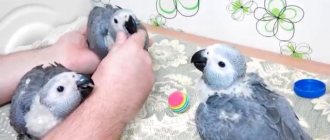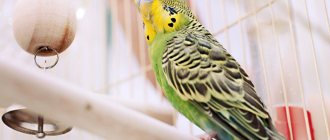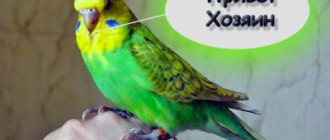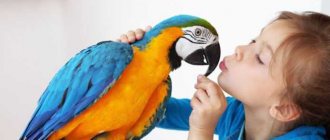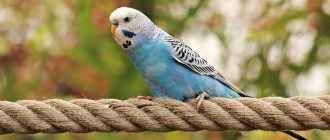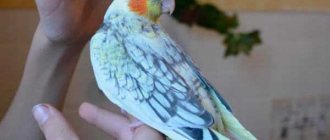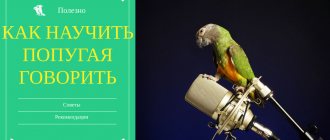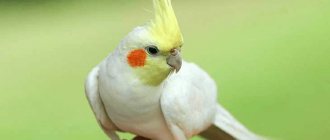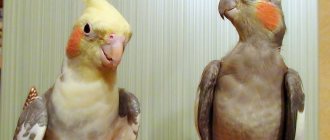The Corella parrot is considered a unique bird that can be kept at home. Nature has rewarded them with amazing abilities and intelligence, which allows them to quickly memorize sounds and human speech. When you hear how a cockatiel talks, you will immediately be surprised that the bird pronounces all the letters and sounds correctly and without errors. But still, teaching her this will require a lot of work and patience. Proper organization of the process is important, which will help the parrot remember a large number of words and sentences.
What to consider before training
All owners want their beloved bird not only to coo peacefully and chirp joyfully, but also to be able to utter some words. However, beginners immediately have a problem - complete ignorance of how to teach a parrot to speak, as well as the main features of special lessons.
A talking cockatiel is not uncommon among parrots of this breed. But in order for him to be able to pronounce words, he needs help in this matter. This bird has abilities, great intelligence, and amazing memory capabilities. This means that speech training will be carried out quickly.
Optimal age
When teaching parrots words, it is important to take into account their age; this requirement is of great importance. Preference should be given to young individuals, they are easier to train. If a cockatiel parrot speaks, then it is probably no more than 2-3 months old; they quickly remember speech.
When selecting a bird depending on its age, it is worth considering some features:
- for learning to speak, it is worth purchasing a bird at the age of 2-3 months;
- Before buying, you need to listen well to the nature of the squeaking of the chicks. A capable and gifted parrot, in addition to squeaking, will make other sounds and change their tonality;
- If you decide to teach an adult bird to talk, it will be difficult. She won't even be able to remember phrases.
Why can't adult cockatiels learn human speech? They have long-established habits and morals, and many do not want to perceive and remember new ones. Therefore, you can’t expect results from them.
Sometimes you can hear your cockatiel already talking. Perhaps the sellers have already taught him how to speak. In this case, you should be prepared for the fact that the bird will cost several times more.
Female or male
Males are believed to be capable students. For this reason, it is worth choosing males for training. Unlike females, they can remember and pronounce 2-3 dozen words and easily remember the simplest phrases.
This is interesting! Do cockatiels talk to humans? Unfortunately, no, they don't understand what people are asking them. They just mechanically repeat memorized phrases.
Is it possible to teach a female cockatiel to talk? They are trainable, but their vocabulary will be small. Not everyone will have the patience or strength to teach a bird some words. But there are situations when females turn out to be much smarter and more agile.
How many words can cockatiels say?
A cockatiel parrot can pronounce a maximum of 30-35 words and a couple of simple sentences. The bird pronounces them unconsciously, on a mechanical level. But sometimes they can be associated with actions, for this reason there may be a feeling that she knows their meaning.
Talking cockatiels can learn to sing. The bird reproduces melodies with ease and can speak several lines of repeated songs.
Why does the cockatiel sing and dance?
Corella, like most other parrot species, is prone to imitation. Initially, singing is a way to communicate with others, including the owner. In nature, birds sing magnificently, but in an apartment with birds you need to work hard to hear the inimitable sounds.
At first, the parrot may make incoherent, high-pitched sounds, whistling or chirping. Under good conditions of detention, positive and regular communication with the owner, the range of vocal capabilities will invariably expand.
A dancing bird is not such a common occurrence, but your feathered friend can easily learn rhythmic movements if you constantly turn on catchy melodies and dance to them. A parrot is able to imitate not only sounds, but also human movements.
How to teach a cockatiel to talk
How to teach a cockatiel to speak at home? To do this, it is important to study the rules of the learning process. It must be done every day. She should not be distracted by objects or toys; it is better to remove them from sight.
Seeing how a cockatiel speaks, a feeling of admiration and interest immediately arises. But still, this is the merit of the owner, because the success of this business depends on adherence to important principles.
Study Tips
The main requirement for effectively teaching a bird to talk is constant communication with it. You need to choose a time when your feathered pet is in a good mood - better in the morning and evening.
So how to teach a cockatiel parrot to talk? Tips to follow:
- each training should last for 15-20 minutes and at least twice a day;
- the first words should be small;
- the beginning of training should be during periods when the bird is in a cheerful state;
- the parrot will be able to quickly remember words that are associated with events - feeding, waking up, hygiene procedures;
- every time you meet a parrot, you need to ask him the question “How are you?”;
- teaching a parrot to talk should be done in silence, there should be no people in the room except the teacher;
- The pet needs to be praised for every sound it makes. The ideal option would be a treat, which should be given to the parrot after the word he has spoken;
- if the bird is not in the mood, it is not inclined to communicate, then it is better to abandon training for a while. Classes cannot be conducted under coercion or force;
- the parrot will quickly learn the words that it hears every day. They need to be said constantly;
- It’s better to select phrases for training in advance and say them to your feathered pet every time. There is no need to throw different words, otherwise he will not be able to remember them;
- Only one person should conduct classes. The Corella parrot will not be able to perceive words that are spoken in a voice with a different timbre;
- learning a new phrase should be carried out only after mastering the previous one. You shouldn’t overload the bird too much right away; it won’t absorb a large amount of information;
- Be patient when practicing. There is no need to shout at the bird, otherwise you may lose contact with it;
- Each word must be pronounced with the same intonation. The feathered pet remembers the word and the tone with which it is pronounced.
What not to do
Many people wonder whether it is possible to teach a cockatiel to speak? Of course you can, but subject to the rules. There are some conditions that should not be met when training:
- It is not recommended to pronounce large sentences and phrases that are difficult to pronounce;
- there is no need to speak words quickly and illegibly;
- You shouldn’t repeat words a couple of times and then start learning others;
- You cannot swear or say obscene words. Feathered pets quickly remember words and passages that are spoken loudly. They will show off their skills to your guests and demonstrate your low level of cultural development.
Learning with technology
How to teach a cockatiel to speak using special equipment? It is worth following the rules:
- decide on the words to teach. For the initial ones, it is worth using words with letters and sounds - r, zh, sh, shch, t, k, yu, i, u, o, a, e;
- each word must be pronounced clearly, loudly and slowly so that the bird can understand it;
- classes should be held every day;
- Praise the parrot for its successes, so it will learn words faster.
If there are two parrots in the house
It is much easier to teach speech to a lonely bird. But what to do if there are two feathered pets in the house? How to teach two cockatiels to talk? Difficulties may arise in this matter, because during the learning process the birds will be distracted by each other and interfere.
If there are two Corella parrots living in the house, then it is better to seat them in different cages and place them in different rooms. They need to be trained in different rooms, this is the only way they will remember the words faster and will not be distracted. And in just a few weeks you will be showing your guests what cockatiels can do.
Training in 1 day
How to quickly teach a cockatiel to speak in one day? To do this, you can use a special technique:
- for training you will need a computer or smartphone on which the words are recorded;
- with the device working, the bird must be left for 1 day;
- throughout the day the parrot will listen to the same words;
- a capable bird will be able to utter 1-2 words by the end of the day.
Singing as a way to communicate with the owner
What kind of singing does a cockatiel have?
Those who have such a bird at home most often answer that the bird’s voice is powerful and varied in tones and timbres. The corra parrot, like many representatives of this family, is capable of reproducing sounds of various frequencies. The singing of the corra directly depends on the conditions in which the bird is. Melodic by nature, like a voice recorder, the cockatiel is able to accurately reproduce what he hears around him. The singing of tamed individuals can resemble a telephone or doorbell, a human voice, melodies from a TV, a barking dog, etc.
With the help of various sounds, the bird communicates with its owner and thus expresses its emotions and desires. Many cockatiel owners note that communication through singing is a new stage in the relationship between humans and birds, which allows them to establish a special emotional contact with their pet and understand it from a “half-sound”. It comes as a surprise to many how many meanings and moods a smart bird can express through sounds. It is especially pleasant to listen to such meaningful singing of cockatiel parrots.
List of words
There are many words and phrases that you can teach your feathered pet. But we will highlight the most popular ones that the parrot will learn quickly:
- Hello;
- Hello;
- guard;
- peach;
- bird;
- piastres;
- ciao;
- it's time to sleep;
- (nickname), good;
- let `s play;
- Protect the environment;
- Good morning;
- Good afternoon;
- I want to drink;
- give me money;
- behave yourself;
- How are you doing.
If a cockatiel parrot talks, then these phrases will sound special to him. For many they will evoke a feeling of tenderness and joy.
Songs and music for cockatiels
Songs for cockatiels are selected individually. Birds react differently to unfamiliar sounds. Some works arouse keen interest in them, while others can even frighten them.
Studies have shown that parrots do not perceive modern music in the style of techno and electro. Classical compositions, especially with the piano, have a calming effect on them, but do not make them want to dance. We need something perky and rhythmic. An artistic whistle is a good choice for a cockatiel.
In general, you need to monitor your pet’s behavior: the parrot will immediately let you know which songs he likes and which ones he dislikes.
Choosing a cage for a talking parrot
Corella parrots lead an active life in nature, but when they find themselves in apartment conditions, they begin to suffer from limited movements in the confined space of the cage.
Therefore, a large cage is selected for the pet’s comfort. You can make it yourself.
Housing dimensions
A cramped cage where it is impossible to spread the wings, and the size of the Karelian wings is about 30 cm, is unacceptable. The parrot's housing must be at least half a meter wide so that the cockatiel does not touch the side walls with its tail and wings and jumps and flutters freely inside the cage. Locked in cramped conditions, cockatiels become ill (obesity, muscle atrophy), become depressed or aggressive, and suffer from baldness.
The distances between the rods should be no more than one or two centimeters so that the pet’s head does not get stuck and is not injured. The horizontal movement of the rods is preferable; this facilitates the bird’s climbing up and down. However, vertical rods also train the paws and their tenacity.
When choosing a cage for cockatiels, you need to take into account the size of the bird.
The cage requires two doors - one for entry, the other for attaching the bathing suit. Sometimes there are cages with a third door - to secure the nesting house (if they plan to breed the cockatiel).
The optimal height of the door is 15 cm so that the parrot can walk through it at full height.
Even a very spacious cage will not replace free flight for Karelians, so it is necessary to let them fly in the room from time to time.
Form
The best cage shape is rectangular with a flat roof. If the parrot gets scared, it can hide in a corner. In a round cage, the parrot will not have this opportunity; this will lead to stress for the pet. The flat top of the cage is convenient if the cockatiel wants to play. For example, hanging upside down. Rectangular cages are easier to clean.
Material
It is best for your pet to purchase an all-metal cage with chrome-plated or nickel-plated bars. Karelians will definitely chew the rods, but if they are painted, then particles of the coating can enter the bird’s body. Copper structures that oxidize over time, as well as galvanized ones, are very dangerous.
Wooden apartments will not last long, because a bird is quite capable of gnawing it and breaking free.
There must be enough space in the cage
Equipment
In nature, parrots are active and enterprising, able to constantly tweet, and are busy searching for food and communicating.
In captivity, these birds become aggressive or capricious, and weaken their bodies if their leisure time is not properly organized.
In addition to the obligatory drinking bowls, bathing bowls, and feeders of various types (for grain feed and for complementary feeding), the cockatiel’s apartment must have:
- rope and wooden ladders, perches made of branches, swings and ropes
- toys (bells, rattles, beads)
- mirror
Toys for Karelians should not have sharp corners, peeling paint, or too small parts.
Cockatiel Nymph Sound Dictionary
A bird living at home, even if it cannot speak, has a wide range of various vocal techniques. Listening to the sounds of Corella parrots, it is easy to understand what mood the pet is in and what worries him.
Here's what a short dictionary of the cockatiel's “language” looks like:
- Corella chirps loudly and intensely - the pet is scared and sounds an alarm. The cause may be a sharp sound or unexpected movement.
- The non-stop, long chirping of a parrot indicates that the bird is bored, thirsty for communication, or ready to mate.
- The pet usually makes sounds similar to hissing in the first days of being in a new place. This is a sign of anxiety, fear.
- The grinding of its beak indicates that the pet is getting ready to sleep.
- The parrot screams and squeals when there is too much noise around its home. Also, the reason for this behavior may be the bird’s reluctance to remain alone, unfavorable environmental factors, or lack of sleep. The cry of a cockatiel in the morning is a natural phenomenon: the bird has woken up and notifies household members about it.
- Cockatiel parrot songs and whistles mean that the pet is in a good mood.
Corella parrots are sociable, friendly, affectionate and smart. Listening to them sing and chirp is a real pleasure. These pets are able to fill any room with positive energy and turn every day into a holiday with their joyful chirping.
If you regularly play this video for your pet cockatiel, after a short time he will begin to play a very melodic and beautiful melody:
Cage Placement Tips
| Undesirable places to place a cage and why | |
| Near heating radiators | Dry air causes itching of the skin of the bird, whose skin is devoid of sebaceous and sweat glands. The parrot may go bald. |
| In a draft | Is fraught with colds |
| In direct sunlight | Overheating and burns |
| Near the TV or stereo system | Stress due to loud and harsh sounds |
| Kitchen | When heated, Teflon releases substances that are toxic to the parrot into the air. Possible steam burns A bird can get burned over a hot burner. |
A great place for a parrot to live in an apartment is a quiet room, but one that is frequently visited. Corella is a member of the family, so he belongs with people, otherwise the parrot will be sad.
Do not place the cage in the kitchen, in drafts, near a window or door
The cage is placed indoors so that one or two walls are adjacent to the wall of the room. If the bird's cage is placed in the center of the room, the parrot may become stressed due to the inability to hide.
There is no need to place the cage high: the cockatiel will decide that he is the boss in the house. It is better to place the parrot’s house at the level of your face - this makes it more convenient to communicate with your pet on an equal footing.
How to achieve good results
Exercises with a parrot will be effective if done two to three times a day. Lessons should be short, no more than fifteen minutes, so that the bird does not get tired.
During the lesson, the bird should not be distracted by anything, so it is necessary to exclude sharp and loud sounds and the presence of strangers in the room. Too many tasks will only confuse the parrot. You need to work on only one task during the day and do it slowly, without pushing your pet, but in every possible way encouraging even the slightest success.
To tame a cockatiel quickly, you need to find out what kind of food he likes best.
